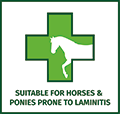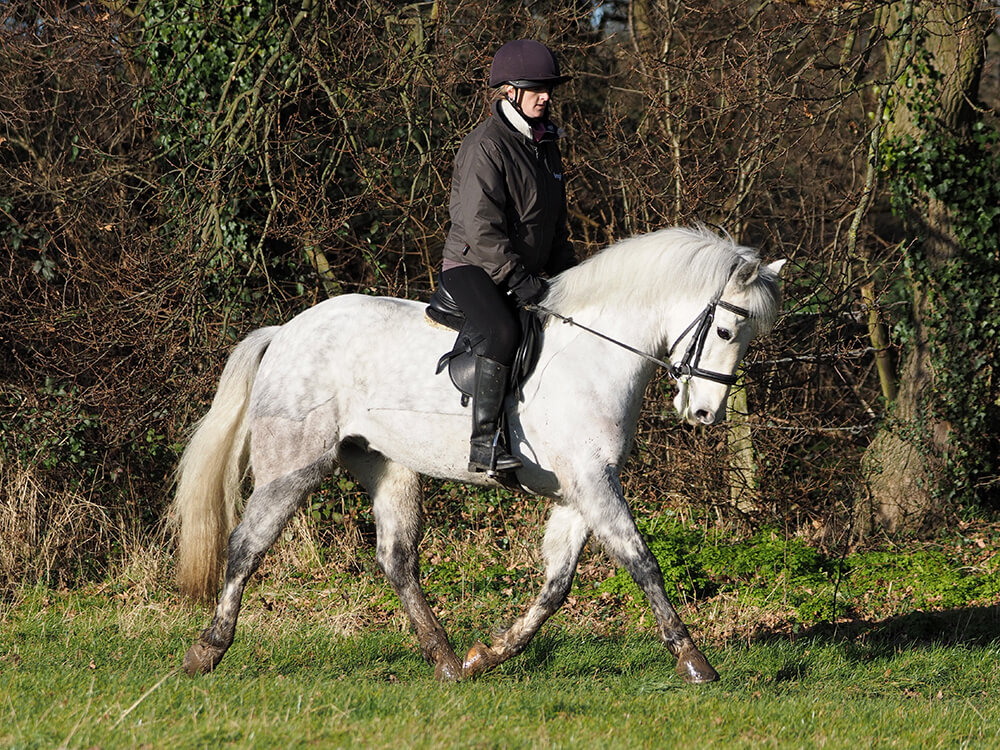Horse Obesity & Laminitis
The rise in overweight and obese horses and ponies could be linked to the number of laminitis cases. Despite continued research, laminitis is a debilitating and painful condition that seems to be on the rise.
The dilemma seems to be that, although most owners appreciate that their overweight or obese horses or ponies are at an increased risk of laminitis, they seem to find it very difficult to diet them effectively. This might be because many people simply don’t realise where the calories (energy) is coming from. We’ll count some calories in a typical ration shortly, but first it is worth understanding a little more about the link between obese horses and laminitis risk.
Obese Horses & Equine Metabolic Syndrome
Equine Metabolic Syndrome is a name used to describe a range of symptoms, including insulin resistance or dysregulation, obesity and recurrent laminitis.
Research in humans in the 1990s demonstrated that adipose (fat) tissue isn’t just an inert store – it can actually develop the ability to secrete hormones. Hormones are chemical messengers in the body and it is known that adipokines (hormones produced by the adipose tissue) can affect immune function, inflammation, tumour development and glucose regulation. Keeping blood glucose levels within normal ranges involves a number of hormones, one of which is insulin. If the function of insulin is compromised, it is referred to as insulin resistance.
Insulin facilitates the removal of glucose from the blood, so insulin resistance can result in blood sugar levels remaining elevated despite more and more insulin being produced. It is thought that over-exposure to insulin and glucose can damage the cells lining the blood vessels (endothelial cells). As these are responsible for the constriction and dilation of blood vessels, the link between insulin resistance and obese horses and laminitis becomes apparent.
How To Help Your Overweight Horse With Laminitis
If you have an obese horse, you will need to embark on a weight-loss plan. The main source of energy in most horses’ diets is grass – eight hours’ grazing time on average spring pasture will supply enough energy for a 500kg horse. It is recommended that you limit your horse’s turnout time to help restrict their main source of calories. Consider stabling, a grazing muzzle and limiting the available grazing area.
How Effective Is A Grazing Muzzle For Overweight and Obese Horses?
There have been very few studies investigating how effective grazing muzzles are, but Tracey Hammond MSc (Dist), a Dengie nutritionist, carried out a study for her master’s degree dissertation. The study showed a 75-85% reduction in grass and energy consumed as a result of the grazing muzzle. Although the study was small-scale, this does show promising and effective methods for restricting intake for overweight and obese horses.
The benefit of using a grazing muzzle is that horses can still be turned out, which is better for their respiratory system and allows them to interact with other horses and move around more, which will use more energy than if they are stood in a stable.
Calorie Counting
It is also important not to be tempted to treat overweight or obese horses with a sprinkling of cubes or mix in their feed. You might be surprised to learn that half a scoop of mix provides enough energy to support 20 minutes’ schooling and, if cubes are used, this increases to 50 minutes because they are heavier.
Benefits Of Exercise
Although it can often seem that however much work you do with your horse it doesn’t seem to lose weight, it is important to keep doing it. Double check that you are sufficiently reducing your horse’s calorie intake through dietary restriction as exercise alone will not result in sufficient weight loss.
It is also important to consider that, even if the horse isn’t losing weight, exercise might help to maintain sensitivity to insulin, as has been found to be the case in humans. Therefore, even if the horse isn’t losing weight, exercise could help to avoid insulin resistance and laminitis.
The Laminitis Trust
The foundation of advice when it comes to choosing the best feed for over-weight, laminitis-prone horses is to choose a product that is high in fibre and provides low levels of sugar, starch and calories. For many years, Dengie feeds have been fed and recommended by organisations such as The Laminitis Trust & The Laminitis Site. Look for these approval marks on our packaging it’s an easy way to be sure that you are choosing a suitable feed.



Jake’s Story
Jake, an eight-year-old Connemara and has always been a good-doer. When he was diagnosed with EMS, his owner Emma Williams knew she had to take action. “I arranged for a Dengie nutritionist to visit and weigh Jake. He was given a personalised diet-plan of Healthy Hooves Molasses Free and we’ve not looked back! Jake now weighs a healthy 417kg – he’s lost an incredible 99kg in the last 12 months! He loves his feeds, is healthy, happy and in great condition.”
To read more about Jake’s weight loss story.





